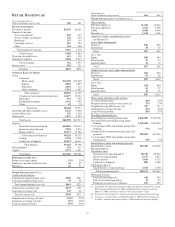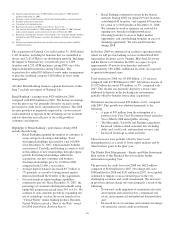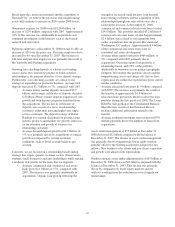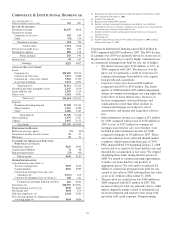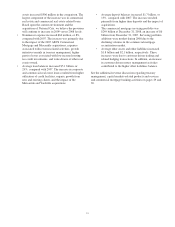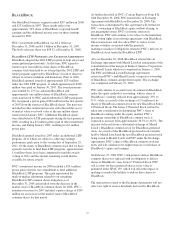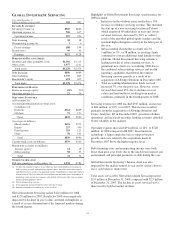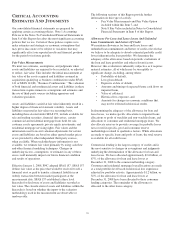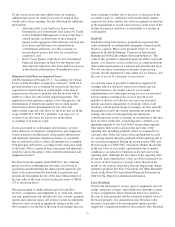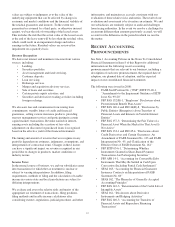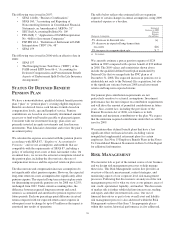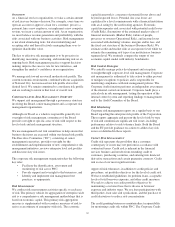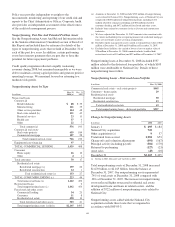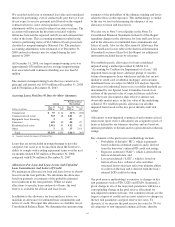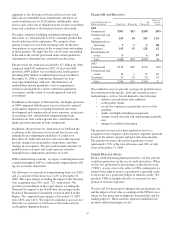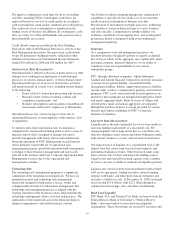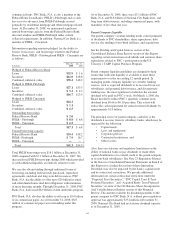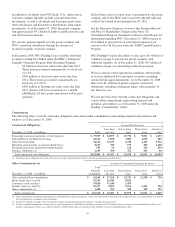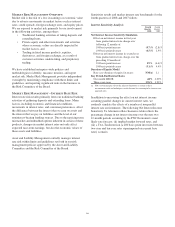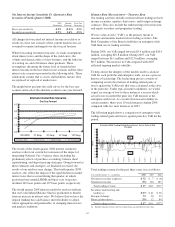PNC Bank 2008 Annual Report Download - page 61
Download and view the complete annual report
Please find page 61 of the 2008 PNC Bank annual report below. You can navigate through the pages in the report by either clicking on the pages listed below, or by using the keyword search tool below to find specific information within the annual report.values are subject to judgments as to the value of the
underlying equipment that can be affected by changes in
economic and market conditions and the financial viability of
the residual guarantors and insurers. To the extent not
guaranteed or assumed by a third party, or otherwise insured
against, we bear the risk of ownership of the leased assets.
This includes the risk that the actual value of the leased assets
at the end of the lease term will be less than the residual value,
which could result in an impairment charge and reduce
earnings in the future. Residual values are reviewed for
impairment on a quarterly basis.
Revenue Recognition
We derive net interest and noninterest income from various
sources, including:
• Lending,
• Securities portfolio,
• Asset management and fund servicing,
• Customer deposits,
• Loan servicing,
• Brokerage services,
• Merger and acquisition advisory services,
• Sale of loans and securities,
• Certain private equity activities, and
• Securities and derivatives trading activities including
foreign exchange.
We also earn fees and commissions from issuing loan
commitments, standby letters of credit and financial
guarantees, selling various insurance products, providing
treasury management services and participating in certain
capital markets transactions. Revenue earned on interest-
earning assets including the accretion of fair value
adjustments on discounts for purchased loans is recognized
based on the effective yield of the financial instrument.
The timing and amount of revenue that we recognize in any
period is dependent on estimates, judgments, assumptions, and
interpretation of contractual terms. Changes in these factors
can have a significant impact on revenue recognized in any
period due to changes in products, market conditions or
industry norms.
Income Taxes
In the normal course of business, we and our subsidiaries enter
into transactions for which the tax treatment is unclear or
subject to varying interpretations. In addition, filing
requirements, methods of filing and the calculation of taxable
income in various state and local jurisdictions are subject to
differing interpretations.
We evaluate and assess the relative risks and merits of the
appropriate tax treatment of transactions, filing positions,
filing methods and taxable income calculations after
considering statutes, regulations, judicial precedent, and other
information, and maintain tax accruals consistent with our
evaluation of these relative risks and merits. The result of our
evaluation and assessment is by its nature an estimate. We and
our subsidiaries are routinely subject to audit and challenges
from taxing authorities. In the event we resolve a challenge for
an amount different than amounts previously accrued, we will
account for the difference in the period in which we resolve
the matter.
R
ECENT
A
CCOUNTING
P
RONOUNCEMENTS
See Note 1 Accounting Policies in the Notes To Consolidated
Financial Statements in Item 8 of this Report for additional
information on the following recent accounting
pronouncements that are relevant to our business, including a
description of each new pronouncement, the required date of
adoption, our planned date of adoption, and the expected
impact on our consolidated financial statements.
The following were issued in 2008:
• FASB Staff Position No. (“FSP”) EITF 99-20-1,
“Amendments to the Impairment Guidance of EITF
Issue No. 99-20”
• FSP FAS 132(R)-1, “Employers’ Disclosures about
Postretirement Benefit Plan Assets”
• FSP FAS 140-4 and FIN 46(R)-8, “Disclosures by
Public Entities (Enterprises) about Transfers of
Financial Assets and Interests in Variable Interest
Entities”
• FSP FAS 157-3, “Determining the Fair Value of a
Financial Asset When the Market for That Asset Is
Not Active”
• FSP FAS 133-1 and FIN 45-4, “Disclosures about
Credit Derivatives and Certain Guarantees: An
Amendment of FASB Statement No. 133 and FASB
Interpretation No. 45; and Clarification of the
Effective Date of FASB Statement No. 161”
• FSP EITF 03-6-1, “Determining Whether
Instruments Granted in Share-Based Payment
Transactions Are Participating Securities”
• FSP APB 14-1, “Accounting for Convertible Debt
Instruments That May Be Settled in Cash Upon
Conversion (Including Partial Cash Settlement)”
• SFAS 163, “Accounting for Financial Guarantee
Insurance Contracts an Interpretation of FASB
Statement No. 60”
• SFAS 162, “The Hierarchy of Generally Accepted
Accounting Principles”
• FSP FAS 142-3, “Determination of the Useful Life of
Intangible Assets”
• SFAS 161, “Disclosures about Derivative
Instruments and Hedging Activities”
• FSP FAS 140-3, “Accounting for Transfers of
Financial Assets and Repurchase Financing
Transactions”
57


